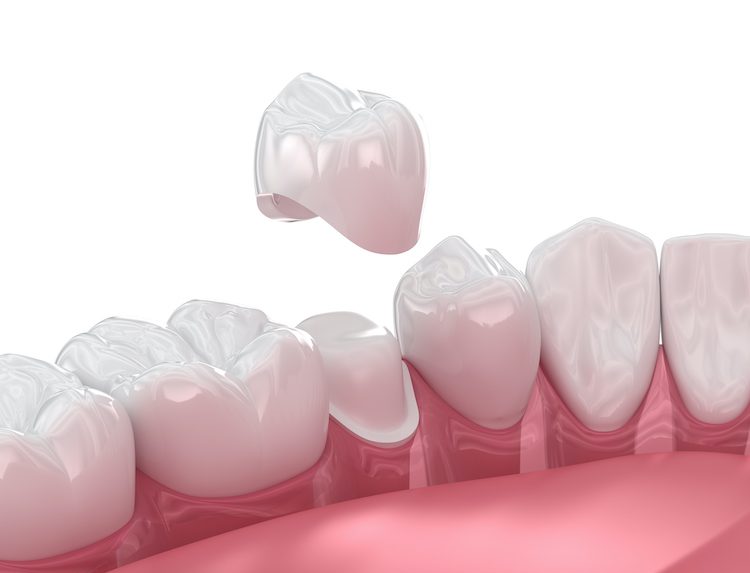Dental crowns serve as a protective cover for damaged teeth. They help restore the tooth’s shape, size, and how it works. Crowns are commonly used in restorative dentistry to treat decay, repair damage, and complete dental implant treatment. We believe that knowing the process of getting a dental crown can ease your anxiety.
Visit Complete Dentistry For All Ages for your dental crown needs. Dr. Morgan Chambers explains the general process below.

Steps to Getting a Dental Crown
Initial Consultation and Examination
Your crown treatment starts with a consultation visit. The dentist will carefully look at your tooth and take X-rays to see what’s going on inside. They’ll check for problems like cavities or cracks to decide if you need a crown, or a different treatment.
During this visit, you’ll have plenty of time to ask questions and talk about any worries you might have. The dentist will examine your whole mouth, not just the problem tooth. They’ll look at your gums and how your teeth fit together to make sure the crown will work right for you.
The dentist will explain all your choices, including other ways to fix your tooth if a crown isn’t the best option. This first visit is important because it helps you and the dentist make a good plan together. You’ll leave understanding exactly what will happen next and why a crown might be the right solution for your smile.
Getting Your Tooth Ready
First, your dentist will carefully shape your tooth so the crown can fit perfectly over it. They’ll gently remove any damaged or decayed parts to make sure only healthy tooth structure remains. They’ll use numbing medicine so you won’t feel any pain during this part.
Next, the dentist takes a mold of your prepared tooth. This mold goes to a special lab where technicians use it to create your custom crown that matches your other teeth. Since making the permanent crown takes about 2 weeks, you’ll get a temporary crown to wear in the meantime.
The temporary crown protects your tooth but isn’t as strong as the permanent one will be. You’ll need to be careful with it by avoiding chewing gum, sticky candy, and really hard foods. Brush gently around the temporary crown too. Your dentist will give you specific instructions to care for it until your next visit when you get the permanent crown placed.
This preparation step is important because it makes sure your new crown will fit, look real, and last for many years. The dentist takes their time to get everything just right so you’ll be happy with your final result.
Creating the Dental Crown
After your tooth is prepared, the real magic happens at the dental lab. Skilled technicians use the exact mold of your tooth to create a crown that fits perfectly. They don’t rush this process, so it usually takes about two weeks to make your permanent crown just right.
The lab uses special materials and technology to match your crown’s color to your natural teeth. They look closely at the shape, size, and even the slight color variations in your smile. This careful work means your crown will blend in seamlessly when you talk or laugh. Many people won’t even notice you have a crown.
While you wait, you’ll wear a temporary crown to protect your tooth. The permanent crown will be stronger and more comfortable. The lab makes sure every detail is perfect so your crown will feel like your own tooth and last for many years.
Fitting the Permanent Crown
When your custom crown is ready, you’ll come back for a quick fitting appointment. The dentist will remove your temporary crown and carefully check how the new one fits. They’ll make sure the color matches your other teeth perfectly and that it feels comfortable when you bite down. After any final adjustments, the dentist will securely cement the permanent crown in place.
Aftercare and Maintenance
To keep your crown looking great and working properly for years:
- Brush twice daily with a soft toothbrush and gentle toothpaste. Be sure to clean around all sides of the crown where it meets your gumline. Floss carefully around the crown every day to remove plaque and prevent problems.
- Try to avoid chewing extremely hard foods like ice or hard candy that could chip the crown. If you grind your teeth at night, ask your dentist about getting a protective night guard.
- Visit your dentist regularly for checkups. They’ll examine your crown to make sure it’s still in great shape and catch any potential issues early. With proper care, your crown can last 10-15 years or longer while keeping your smile looking natural and beautiful.
Remember to call your dentist if you notice any changes like discomfort, looseness, or damage to your crown. They can fix it right away.
What to Expect After Getting a Crown
While most patients heal quickly after getting a crown, some temporary sensitivity is normal. Your tooth might feel a little tender when biting or reacting to hot and cold foods for a few days. This discomfort usually goes away on its own as your mouth adjusts. However, if the pain gets worse or doesn’t improve after a week, you should call your dentist.
A loose crown is something you’ll want to get checked right away. If your crown feels wobbly or comes off completely, save it and contact your dentist immediately. Waiting too long could lead to more damage to your tooth underneath. Following your dentist’s care instructions greatly reduces the chance of any problems.
Complete Dental Care for Your Family
At our practice, we provide full-service dental care for patients of all ages. Our friendly team focuses on making every visit comfortable while delivering high-quality treatment. We use modern technology and techniques for all procedures to give you the best results possible.
Whether you need preventive care, restorative treatments, or cosmetic dentistry, we’re here to help you achieve and maintain a healthy smile. Dr. Chambers takes time to explain all your options and answer any questions you have.
Are you ready to improve your smile? Call us today at 859-251-3809 or request an appointment online. We’ll examine your teeth, discuss your needs, and create a personalized treatment plan to keep your teeth strong and looking their best.
